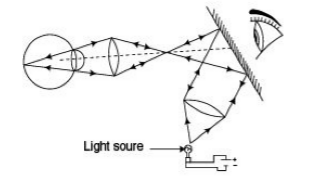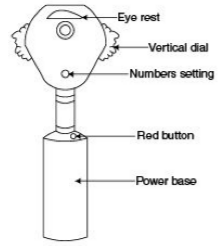Ophthalmoscope is an instrument used to examine the interior of the eye including the lens, retina, and optic nerve. It is used primarily to:
- Assess the conduction of fundus of eye
- Detect the opacity of the ocular media
Ophthalmoscope is based on the principle that, light entering the pupil is reflected back to its source. Furthermore, the light follows the same path out of the eye that it took while entering the pupil. This instrument was invented by Physician, Helmholtz. Using his improvised Ophthalmoscope, Helmholtz could place his eye in the path of the rays of light entering and leaving the patient’s eye, thereby allowing the patient’s retina to be seen as shown below:

There are 2 main types of Ophthalmoscopes, namely:
- Direct Ophthalmoscope
- Indirect Ophthalmoscope
Direct Ophthalmoscope
It produces upright or unreversed image of approximately 15 times magnification. It is an instrument about the size of a small torch with several lenses. Examination distance has to be maintained as close to patient’s eye as possible. This is the most commonly used instrument during a routine physical examination.

Indirect Ophthalmoscope
This type of Ophthalmoscope produces inverted or reversed direct image of 2 or 5 times magnification. It constitutes a light attached to a forehead, in addition to a small hand-held lens. It produces a wide view of the inside of the eye. It allows a better view of the fundus of the eye even if the patient’s eye lens is clouded by cataract. It is commonly used for peripheral viewing of the retina.

Related: Ophthalmoscope Diagnostic Set
Find out more about: Fingertip Pulse Oximeter Blood Oxygen Saturation Monitor
Bottom line
Generally, Ophthalmoscope is used as part of a routine or complete eye examination. It is used to detect or evaluate the symptoms of retinal detachment or eye diseases such as glaucoma.
You can also read: The Role of Biomedical Analysis in medical diagnostics

Leave a Reply
You must be logged in to post a comment.